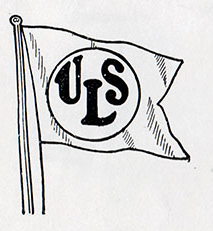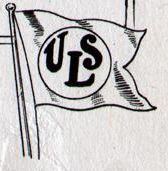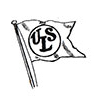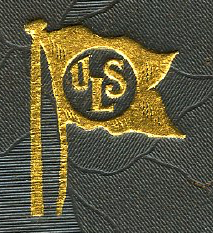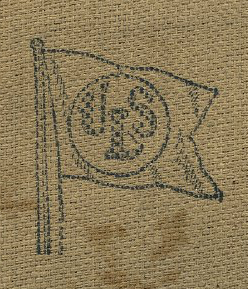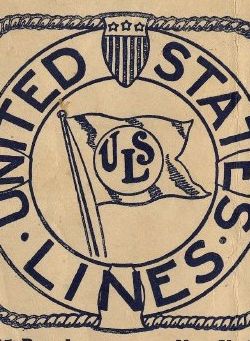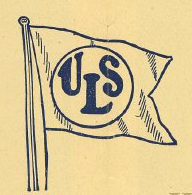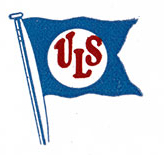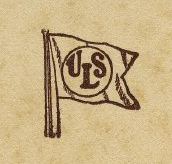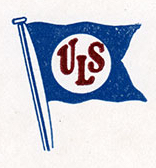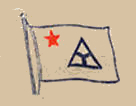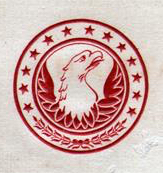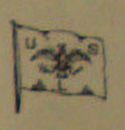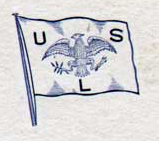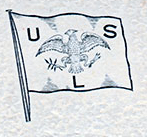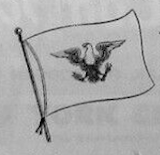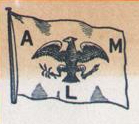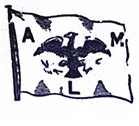From its inception to its dissolution, United States Lines (USL) tinkered with the most visible element of its corporate identity: its house flag. Among merchant seamen, a steamship company’s house flag was colloquially known as the “Bread and Butter flag,” yet among United States Lines employees, it was first called the “Blue Goose” through the 1930s and 1940s, and later the “Screaming Eagle” during the company’s halcyon SS United States period. Yet, a bird did not always grace the USL flag.
Painting USL corporate logo and house flag changes with broad strokes:
1921-29 USL was a post-World War I United States Shipping Board (Federal emergency agency created by the “Shipping Act” (39 Stat. 729), September 7, 1916) company; its agents were Roosevelt Lines among others. In 1921 the USL house flag was flown for the first time; the company was identified by a blue swallowtail flag with the Deco letters USL in red on a white disc:
One of the largest of Saturday afternoon armadas, consisting of ten ships, bound for eight European countries, got away yesterday [September 3, 1921]. The most interesting ship to Americans was the George Washington, which left Hoboken flying the new house flag of the United States Lines, consisting of a white circle on a blue field, within which are the letters U. S. L. in red. This is the first time the liner has flown these colors, as on her maiden voyage under the American flag last month she was a United States Mail liner.
“30 of 52 liners at sea are bound for Europe.” New York Herald (New York, New York), (Sunday) September 4, 1921, p 26.
In 1924, at least, the stacks of USL ships had the familiar red, white, and blue bands at the top – but also the United States Shipping Board (USSB) shield (see February 1923 for a modified logo).
1923-29 For the brief career of the SS Leviathan under the command of Commodore Herbert Hartley, she flew the USL house flag, yet had a distinct logo used on cap badges, buttons, and for the ship’s visual identification: an eagle’s bust ringed by thirteen stars, with two crossed laurel branches at the base of the ring. Under Chapman (see below) and through 1934, the ship’s company no longer wore distinctive uniforms, but the logo remained on onboard ship publications.
1929-31 Paul W. Chapman & Co. purchased both USL and American Merchant Lines (AML) from USSB on 14 February 1929 and merged them as United States Lines (Inc.); he proceeded to nearly sink the company. Thus far there are two flags identified as flown during the Chapman era. The first was hoisted above the SS Leviathan on the morning of 8 April 1929 by Joanna Chapman, the daughter of Paul W. Chapman. This flag was described by the press as a “white field, red star, and blue triangle.” The blue triangle – speculated in some circles as a stylized propeller – was reportedly a Chapman family crest and the propeller is the letter “Y.”
In October 1930, a second flag appeared on USL and AML ships: one that uses the Chapman crest in red and circumscribed by a blue band with the USL name in white block letters. The logo is on a white field without a red field. This same flag and logo were also used by the American Merchant Line (AML).
1931 The U.S. Government re-took control of the company. The USL house flag became the red triangle with a blue circle device on a white field – absent the red star.
1932-1939 Under International Mercantile Marine ownership, USL and AML had the same house flag as the very successful Panama Pacific Line (PPL) – the yet-to-be-dubbed screaming eagle – albeit with the letters USL and AML – respectively – flanking the central eagle. The eagle was dark blue.
1939-1969 PPL dissolved with USL taking PPL’s flag. The house flag was tinkered with one last time in 1947: the eagle’s dipping wings changed to straight, streamlined wings, and it got a haircut. The sometimes scrawny and disheveled goose (vid.: August 1939) was a “Screaming Eagle” at last.
American Line flags
American Line was the steamship line from which IMM took the most enduring image of its corporate identity: the blue eagle. It was formed in 1871 and merged with several others to form IMM. By 1932, the Line faltered and the core of its remaining assets and livery went to PPL.
Panama Pacific Line flags & logos
Just as PPL took the insignia of the older IMM subsidiary, American Line when it dissolved in 1932, so did USL take PPL’s upon its demise six years later. Faced with insurmountable financial and labor set-backs, the Line shuttered in May 1938. As can be seen in the gallery, the changeover for the USL fleet to the new house flag was not completed until mid-1939; the sister ships SS America and SS Washington took the new house flag first. What assets remained of PPL were transferred to Moore-McCormack Lines.
USL flags & logos
The below gallery details USL logos and flags found on various pamphlets, documents, passenger lists, and other ephemera from both the AMMM and my collections. Unless indicated otherwise, the images are from passenger lists from various USL ships.
American Merchant Lines flags & logos
Although American Merchant Lines is not directly connected to the “genealogy” of the development of USL flags, it operated in parallel with USL. After the general failure of Dollar Line to manage its ships, USSB seized its ships and organized a number of them into American Merchant Lines in 1923. J. H. Winchester & Co. was tapped as the U.S. Government’s agent. The Line was later sold to Paul W. Chapman & Co. in 1929 along with USL. Despite AML generating a profit, the overall balance was not in Chapman’s favor, and the USSB sold both to IMM in 1932. AML was a favored “one class” line by budget-minded travelers, but it too failed and was merged with USL in 1937. On the eve of the Second World War, USL sold the old AML ships to a Belgian shipping concern as part of USL subterfuge to circumvent the United States Neutrality Act. Note the change in company livery in going from J.H Winchester & Co, management to that of IMM. IMM used the old American Line flag albeit with AML surrounding the blue eagle – just as it had with USL.
References
“Chapman Take Over Leviathan for $4,000,000.” Daily News (New York), April 9, 1929, p. 50.
“30 of 52 liners at sea are bound for Europe.” New York Herald (New York, New York), September 4, 1921, p 26.
Many thanks are due to Dr. Joshua Smith of the American Merchant Marine Museum for granting me access to the PPL and USL passenger lists, and Robert Sturm at the United States Lines Archive for his sage insights on USL culture.
The header image is a circa 1963-1967 flag in the United States Lines Room at the AMMM (accession number 1981.225.0001).










